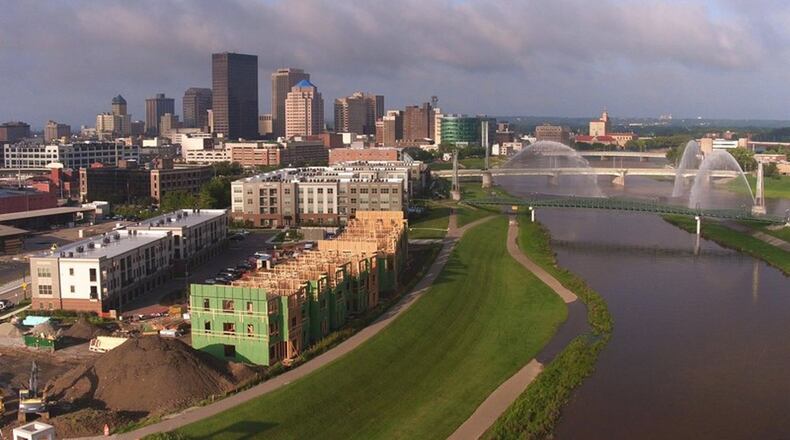The program incentivizes property improvements and new construction by exempting taxation on the value of the improvements. Abatements usually are for 100 percent of the value of the improvements for up to 15 years.
About 313 residential properties in Dayton receive property tax abatements through the program, according to city of Dayton data. As of last year, nearly $63 million was invested in Dayton properties in the community reinvestment program.
RELATED: New Dayton Arcade partners part of amazing Midwest transformations
Home prices have been rising in downtown, Webster Station and other parts of Dayton, but because of the program, buyers can see significant savings on their property tax bills, which encourages the purchase of larger, nicer or more expensive homes, experts say
“Our buyers getting 10- or 15-year tax exemptions is a big deal for them and it helps with our sales,” said Charlie Simms, one of downtown Dayton’s biggest new home developers.
Some of Downtown Dayton’s newest homes are selling for prices that were once unimaginable to developers a decade ago.
RELATED: New downtown Dayton homes sell out
The new City View townhouses near Warped Wing have sold for more than $330,000. Some of the Brownstones at 2nd townhouses near 2nd Street Market have sold for more than $250,000. One of the new Monument Walk townhomes near the Dayton YMCA recently sold for more than $600,000.
Charles Simms Development was behind all three projects.
But while purchase prices have risen, buyers are getting the benefit of having most of their property taxes abated for as long as a decade and a half.
RELATED: Area company to add 200 jobs, invest $73M in manufacturing expansion
Owners still owe taxes on the value of the land before the improvements. But that is usually a small fraction of what they would pay otherwise.
For instance, one of the new Brownstones at 2nd townhomes in October sold for $295,000.
The owner owed $1,295 in property taxes this year. That’s because the unimproved value of the land was $45,000.
But the value of the improvements (the new home) was about $231,490, which means the property taxes without the abatement would cost an additional $6,286 annually.
The property taxes on the improvements to the Browstones at 2nd are 100 percent abated from 2016 to 2030. Abatements can help the resale value of a home while they are still in effect.
Out of 46,582 residential properties in Dayton, just 313 receive property tax abatements through the city’s community reinvestment area program.
RELATED: Twin Towers neighborhood getting facelift, ‘one home at a time’
Almost one-quarter of those properties are in downtown, and there’s also dozens in the Webster Station and Oregon District areas at the edges of downtown.
Simms said the tax abatements help his projects “tremendously,” and the incentives give his lenders confidence they will have sufficient sales.
Unlike some communities, which designate all the property inside their municipal boundaries as community reinvestment areas, Dayton uses the tool much more strategically and effectively, said Karl Keith, Montgomery County auditor.
The program is intended to help cities stabilize neighborhoods, and the city has used a targeted approach to assist the neighborhoods that need it most rather than offering these tax breaks on a wide scale, Keith said.
TRENDING: Wintry mix, accumulating snow expected to cause slick conditions this week
“We know that urban decay and blight is one of the causes of some of the dramatic declines in property values we have seen in recent years,” he said. “Dayton’s strategic use of the CRA program will help to reverse this trend over time.”
Dayton’s community reinvestment areas cover less than 15 percent of the city’s area, said Peter Thornburgh, community development specialist II with the city.
The CRA program provides a strong incentive for homebuyers to reinvest in areas that have seen little development, Thornburgh said.
“For developers, the exemption often makes the financing work for a project or in an area that otherwise would not be bankable,” he said.
Twin Towers has the most properties in the program, with 82.
Blighted homes in the Twin Towers neighborhood were removed and replaced with new affordable housing as part of a project by East End Community Services.
But of the $62.7 million invested in CRA properties, the Webster Station area accounted for more than $20 million of the investment, the most in the city.
Twin Towers’s CRA investments exceed $6 million.
The two downtown CRA districts saw nearly $16 million in property improvements.
Webster Station is home to the massive and growing Water Street District, which has recently welcomed 348 new apartments and have more under construction.
RELATED: Tax change could mean more upgrades for Dayton properties
Dayton’s Community Reinvestment Area program
Here’s a list of some Dayton properties that receive property tax breaks through the program.
Patterson Place, 18 townhomes on the 200 blocks of Ice Avenue and East First Street downtown, abatement period is from 2014 to 2023. Homes sold for $185,000 and up, according to auditor records.
Wheelhouse Lofts, 40 apartments at 210 Wayne Ave. in downtown east area, abatement period is through 2032. Apartments renting for $945 and up.
Sixth Street Lofts, 17 condos at 207 E. Sixth St. in Oregon Historic District, abatement period is 2014 to 2023. Lofts sold for $135,000 and up.
Brownstones at 2nd, 24 townhouses on the 500 blocks of North Ford and East Second streets in Webster Station, abatement period is 2016 to 2030. Homes sold for more than $250,000.
Water Street Flats, 215 apartments spread across multiple buildings along banks of Mad River near Riverscape, abatement period is 2016 to 2030. Apartments rent for $825 and up.
Twin Towers Crossing, 84 new homes in the Twin Towers neighborhood on Dayton's east side, abatement period is 2011 to 2020 or 2013 to 2022. Homes can rent for as little as $300 per month, but families must meet income qualifications (60 percent of area median income).
About the Author

